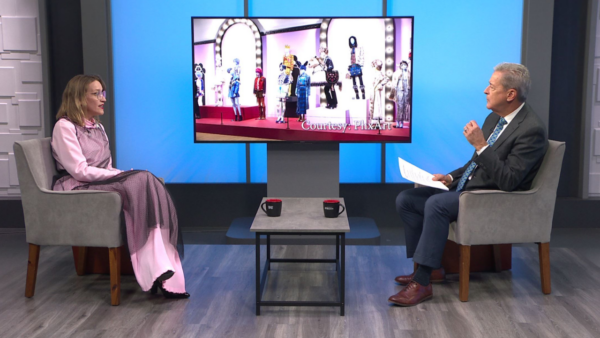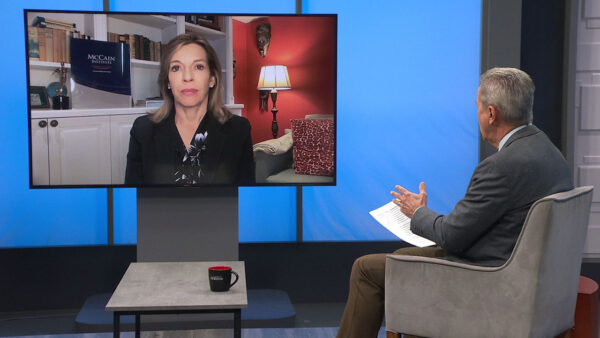The Mesa Takes Flight festival, held this past spring, was the culmination a year-long celebration of aviation, aerospace and all things flight-related. This segment focuses on a festival highlight, a dance piece commissioned by the Mesa Center for the Arts and how different groups and individuals within the community came together to create the finished performance.
Ted Simons: The Mesa takes flight festival which was held this past spring, was the culmination after year-long celebration of aviation, aerospace, and all things flight relate the. On tonight's "Arizona Artbeat," we look at highlight of the festival, a unique dance piece commissioned by the Mesa center for the arts.
David Majure: For seven decades, flights has played an important role in the growth and development of the city of Mesa. From the early days of falcon field which served as a training base for World War II pilots, to a resilient aerospace industry. Flight in its many forms has made a lasting impact on the community. It also was a fitting theme for the city's year-long celebration marking the Arizona centennial.
Cindy Ornstein: Flight is this wonderful symbol of progress and innovation and freedom, and by being the theme for the centennial, it was a statement about Mesa itself. Mesa takes flight is really a commentary on where Mesa is going as a community that we're on the cusp of the next big thing, and the development of our community into the place that we want to go. And that we do love, and that's what flight represents to us.
David Majure: The Mesa takes flight project served as an umbrella for a number of different programs and activities. Culminating in a three-day event that took place in February at the Mesa arts center. It offered those who attended much to see and do. It also served to showcase a very unique performance.
Mandy Buscas: Mesa takes flight was a great program. It had a lot of layers as far as our educational and outreach goals that we were looking to accomplish, and experiences that we were looking to provide to the community. One of the primary outcomes was this amazing community dance that came out of this.
Lana Lee: The dance element consists of interviews, visuals, sound scores, and a lot of different people from different backgrounds, so it's a lot of different perspectives and stories that come together to create the gestures which is the phrase work of the project.
David Majure: For choreographer Elizabeth Johnson, the task of creating the Mesa takes flight dance performance began months earlier, with a series of workshops that involved a cross-section of the community.
Elizabeth Johnson: There's many different things that a choreographer can do. And many different ways of designing movement in space. So sometimes a choreographer will come in and teach the dancers the movement. And that's not what happened at all in this case. I came in and asked a lot of questions. And I started first at fellowship square.
David Majure: The fellowship square senior living community is a partner in the Mesa arts center's creative aging program. Johnson worked with the residents there, helping them to express their experiences and feelings about flight through physical movement. Which later would be incorporated into the finished dance. The choreographer also collected flight-related stories from other sources as well. Including aerospace engineers, pilots, and the dancers themselves.
Elizabeth Johnson: I'm listening not only to what people say, but kind of the movement language that comes out much people when they describe things that they're connected to. When you have that connection with what you're talking about, words aren't enough. And you are literally moved to move. So part of my collecting is listening to the stories, listening to the ideas, Pakistani attention to my own imagination, but also watching for the gesture. Those gestures are the seeds from movement.
David Majure: As the choreography began to take shape, so did the dance ensemble. Participants represented a variety of ages, backgrounds, and levels of experience, and included trained dancers. Once assembled, they were organized into flight themed groups.
Lana Lee: There are captains, and then there are pilots. And so the captain is the core group, we're the ones who remember the material, who help generate it, who stage ourselves in places so other people can watch. And follow along. And then their pilots are people that maybe have never danced before. Definitely not outside. They have questions about what it means to be a performer. They might be older and have never, ever thought about dancing, but this is the first time they're doing that, so it's exciting for them to participate and try something new. But within that structure we have captain and pilots working together in the dance project.
Elizabeth Johnson: It's impossible to think about a community dance and think about only young trained dancers. I love what happens with people who don't normally think of their bodies as a vehicle for communication to step into the studio, to learn dance phrases, to perform and all that that happens, that magic when you step up to that place.
David Majure: The project proved equally satisfying to the dancers.
Mary Jane Machee: I love dancing, and I've done dancing for several years. Years ago, not recently. So I wanted to see what was offered that included the seniors. I was really pleased that the seniors were included in this. I loved all of it. Once I learned what it was about, I decided to stick with it. I came to the rehearsals and I enjoyed it all. It was good to be part of this type of celebration for not only Mesa, but for Arizona, the centennial.
Omaya Ahmad: I've been dancing for years, since I was a kid, but I hadn't experienced doing it in a community setting. It exceeded my expectations. The people I worked with during the performance, the energy, and the commitment to really getting things perfect and putting on a show, and working with each other to do the best show possible, it was such an enjoyable experience.
David Majure: After months of preparation and surmounting many challenges, the Mesa takes flight dance took off in the heart of the Mesa arts center. Warmly received by the audience, its impact extended far beyond the performance itself.
Mandy Buscas: What it's taught us is that these experiences have a life and so what we've done is we've actually continued to provide workshops and invited the Mesa takes flight dancers and community to continue their learning and continue to dance together, to dance socially, we were really excited to see that this is exactly what we were looking to do, to build these entry points into the arts and to have people build a lifelong interest.
Cindy Ornstein: I really feel very gratified by the outcome of the project on multiple levels. I feel that the people who participated were touched deeply and formed relationships that are lasting. For the audiences, people were surprised and delighted. I personally found the piece extremely satisfying artistically as a statement about Mesa, as a statement about flight and most importantly, as a sign of the value of collaborative activity.























